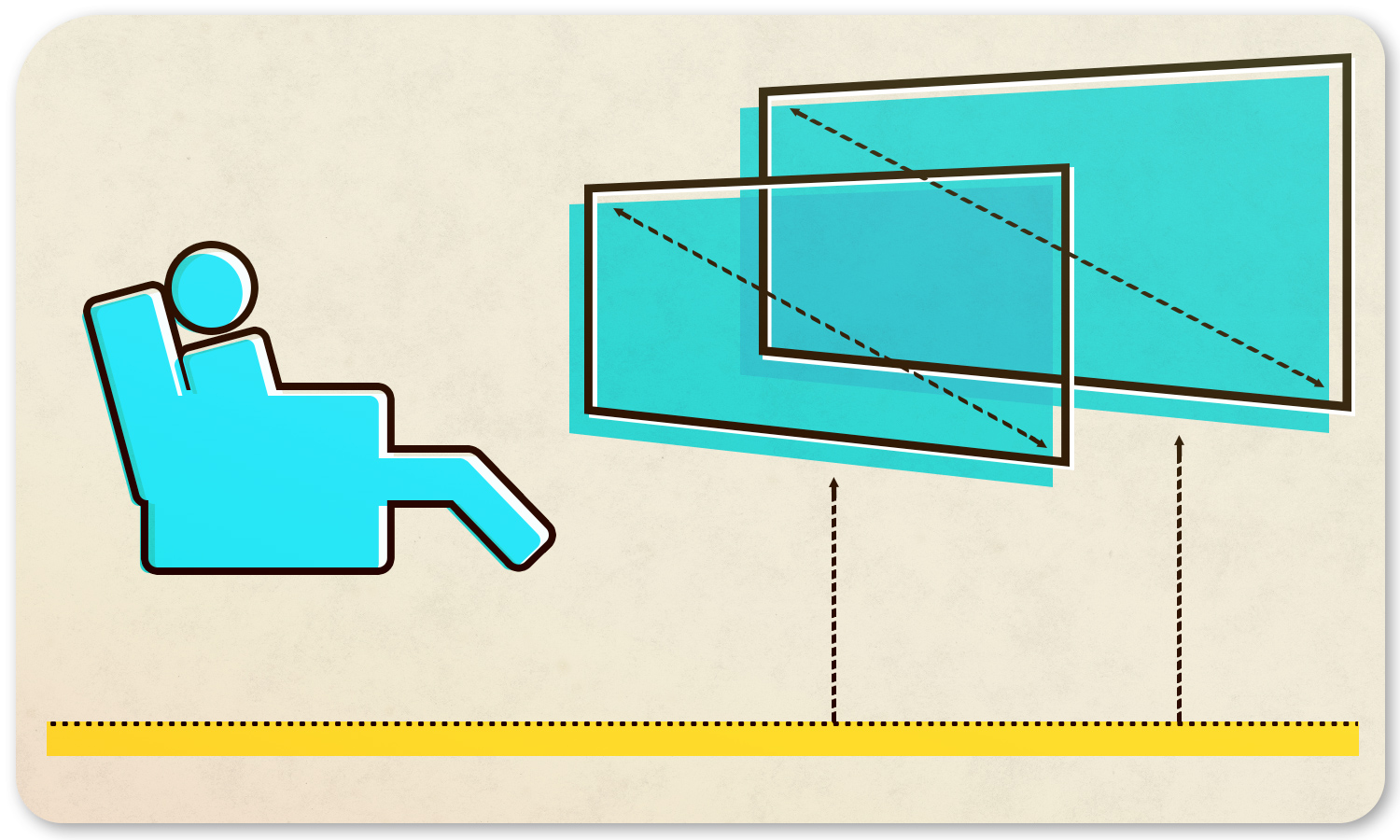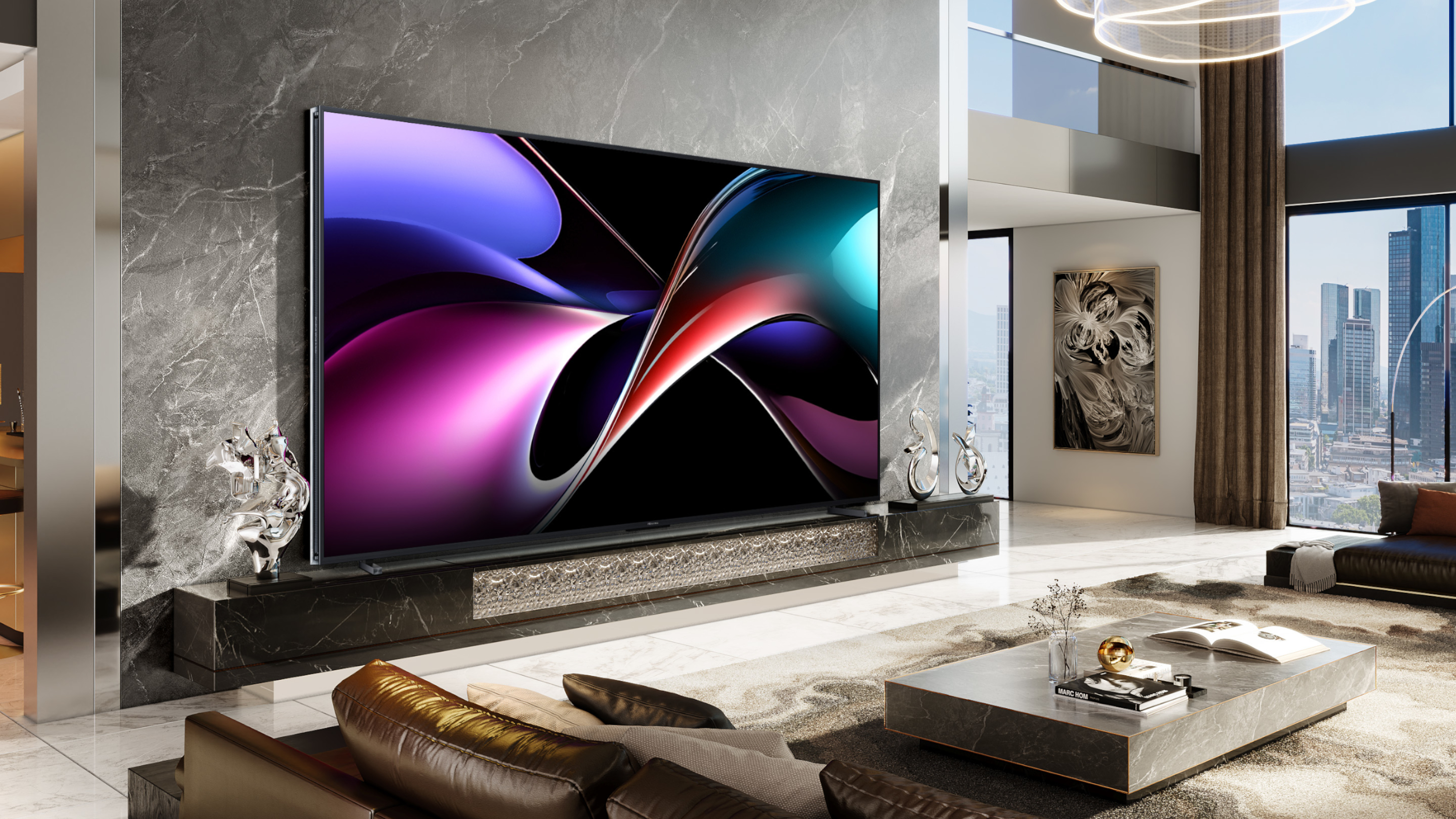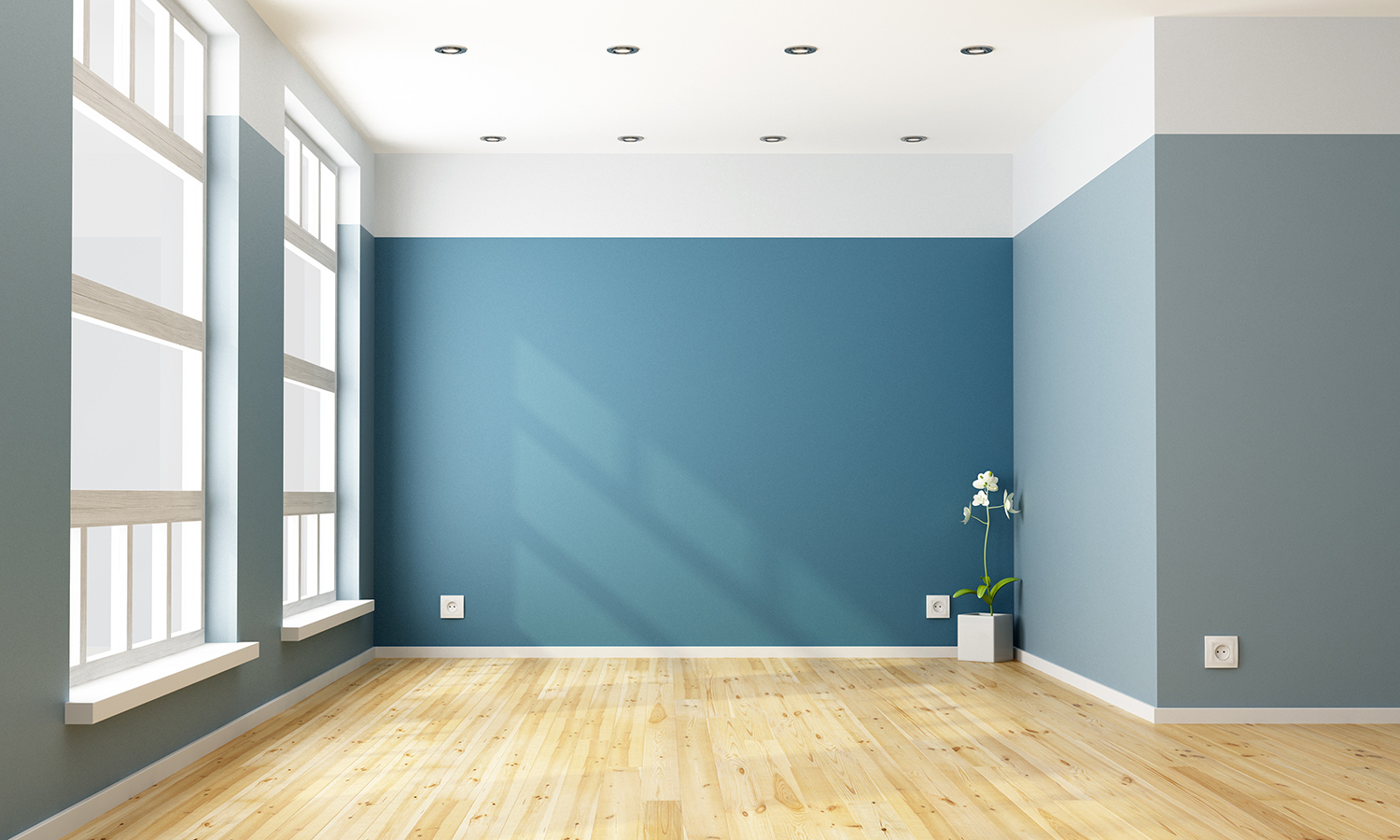What size TV should you buy?
What size TV do I need? How to figure out the right size of TV for your space and comfort.

Not sure which TV size to buy? We've all been there before. As TVs become larger, it can be hard to know what the best size TV might be for your particular living space. But we're here to help you uncover what size TV should you buy, unlocking the fullest potential of your home entertainment setup.
At my house, I have a 55-inch, 65-inch, 75-inch and 110-inch TV all setup in different-size rooms. In my bedroom, where I'm at most seven feet away from the screen, I have a 55-inch TV. In my living room, I have a 65-inch TV and couches that sit about 8 feet back. Finally in my office and home theater are the 75-inch and 110-inch TVs. Both are slight overkill given the size of those rooms, honestly. The point here is that I'm someone who's got almost every size TV in his house and have gone out of my way to try to replicate every sort of viewing distance scenario.
Of course, these are just rough approximations. If you want more exact numbers, I've included a handy guide below. The data generated here is based on THX's recommendation that a TV fill between 25% and 40% of your field-of-view from wherever you're sitting.
| Distance from TV | Minimum screen size | Sweet Spot | Maximum screen size |
| Between 2 and 3 feet | 25 inches | 32 inches | 40 inches |
| Between 4 and 5 feet | 30 inches | 48 inches | 55 inches |
| Between 6 and 7 feet | 55 inches | 65 inches | 75 inches |
| Between 8 and 9 feet | 65 inches | 75 inches | 85 inches |
| Between 10 and 12 feet | 75 inches | 85-inches | 98 inches |
The technical answer may not always make sense for your personal space and eye comfort. Therefore, we really recommend measuring the space to see what will look good there and what feels like it's comfortable before buying a new TV. (Moving into a dorm? Read our guide on what TV size will you need for your dorm room.)
- Check out the best TVs we've reviewed
- TV shopping? Everything you need to know about buying a TV
- The best TV mounts to hang your set on the wall
What size TV do I need? Quick Tips
Why you can trust Tom's Guide
Understand screen size. TV screens are measured diagonally from corner to corner, so a 65-inch TV is closer to 55 inches wide. Bigger is better, in most respects. The bigger a TV is, it's more immersive and easier to see, not to mention more impressive when showing off to the neighbors. That said, if the screen's too big, it won't fit in the space you have.
Know your resolution. TVs today offer three resolution options – 1080p, 4K and 8K. We recommend 4K for pretty much everyone, but the resolution will change how close you can sit to a set and how expensive it will be.
Figure out room size and position. Rooms don't get bigger to accommodate larger TVs, so find the right size for your space.
Screen size and resolution
When asked why someone is buying a new TV, I usually get one of two answers. Either they're replacing a TV that recently broke, or they're moving and they need a larger TV to fit their new space. In almost every scenario, however, that person is looking for a larger TV than what they had previously.
Bigger TVs are certainly more visually impressive but, as I'm sure you've figured out, they allow you to sit a little farther away and still see all the details. To that end, larger screens are best watched from farther back. If you sit too close, you can find yourself unable to see the whole picture, or experience unwanted distortions and color issues. It also can make you feel queasy if you're sensitive to motion.
Of course, screen size describes the physical measurements of a display, but resolution ultimately dictates the pixel density of the screen. There's diminishing returns when pixels are too close together, but for TVs 48 inches or larger, you're going to want a 4K TV. If you go larger to fit your space, you might want to even consider an 8K TV, but be warned: There's no native 8K content out there to speak of, so you're basically paying extra for a processor to upscale 4K content to fill the screen.
As a general rule of thumb, we recommend 4K for pretty much everyone, but the resolution will change how close you can sit to a set and how expensive it will be.
Here's how the main resolution options break down:
1080 or Full HD: Display resolution measuring 1920 x 1080 pixels, used in modern television broadcasts, cable and satellite TV, Blu-ray media and available broadly in free and paid streaming services. You'll still see these, especially when you go looking for the cheapest TVs on sale. Full HD is a good choice if you're getting a TV with an extra-small screen, but for anything larger than 40 inches, you should be getting 4K.
4K (Ultra HD): Display resolution measuring 3840 x 2160 pixels, commonly referred to as Ultra HD or UHD. The current standard in smart TVs, offering 4x the resolution of full HD. We strongly recommend 4K for everybody, in most situations.
8K (Ultra HD): The next step in resolution is 8K, or 7680 x 4320 pixels. It's also called Ultra HD (just like 4K), so don't be confused. There's also a severe lack of 8K content, so we recommend skipping 8K this year. Even on sale, it's more expensive than an equivalent 4K TV.
Check out the top TV models in either resolution:
The best 4K TVs | The best 8K TVs

Room size and TV position
Consider the room in which the TV will sit. As long as the furniture in that room is not permanently attached to the floor — and you're willing to move it — then you have some flexibility in the size of the TV you can get.
Use the guide above to mark out where your couch is, then take a tape measurer to where you plan on putting the TV. If you have a hard time visualizing how big a potential new TV would look in your room, you can also use painters tape to roughly outline the dimensions of the TV in question.
You'll also want to decide at this stage whether you plan to set up the TV using the included stand or use a wall-mount to hang it. Using the included stand to set the TV on a table or entertainment unit will place the set closer to the viewer, shortening the viewing distance. Be sure to account for both the depth of the TV stand and whatever furniture you plan to set it on. Some sets have relatively narrow stands, but others extend back nearly 9 inches with the stand attached.
Hanging the TV on the wall, on the other hand, can add a foot or more to the viewable distance, which can be the difference between a 65-inch TV and a 75-inch model. (Check out the best TV mounts for our favorite mounting hardware.) Depending on what sort of mount you use and the thickness of the TV, your screen will still sit a few inches from the wall, but the specifics will vary from one model to the next. Some, like the LG G4 OLED or Samsung's The Frame are designed to mount flush against the wall, but most will still need some space to accommodate mounting hardware.
MORE: Best Viewing Angle and Height to Mount Your TV
What's comfortable for you?

The typical TV-watcher sits 9 feet from the screen, which brings us to the comfort factor: Most people like to sit far enough away from a TV that the pixels on the screen can't be distinguished. So, feel free to experiment with the placement of your new TV, and it never hurts to go a little bigger than what you think you'll need.
In the end, it's all about what's comfortable. Our numbers are based on years of consumer research and professional TV installers, but that means nothing if your eyesight is less-than-ideal or sitting too close to a TV makes you nauseous.
If you're really not sure what size TV you need, use tape to outline the space or buy from a retailer that has a 100% satisfaction guaranteed return policy with no restocking fees. That way, if it doesn't fit quite the way you expected, you can return it for a different size with no extra hassles.
Whether you're shopping for a TV for your home or a home for your TV, you should now have everything you need to make the best decision possible.
Sign up to get the BEST of Tom's Guide direct to your inbox.
Get instant access to breaking news, the hottest reviews, great deals and helpful tips.

Nick Pino heads up the TV and AV verticals at Tom's Guide and covers everything from OLED TVs to the latest wireless headphones. He was formerly the Senior Editor, TV and AV at TechRadar (Tom's Guide's sister site) and has previously written for GamesRadar, Official Xbox Magazine, PC Gamer and other outlets over the last decade. Not sure which TV you should buy? Drop him an email or tweet him on Twitter and he can help you out.
- Brian Westover
- Ryan EppsStaff Writer
-
glenaw In this article the distance calculation that is made is for distortion on the pixel lines. That is the only consideration that the article is making. The other consideration should be the peripheral vision. If you are placed so close to the TV yours eyes will be shifting constantly to view the area of view which will make it difficult and unpleasant to your vision. This should be your first consideration. After considering that one can make the other considerations to make your viewing a pleasurable and complete experience.Reply -
Geodude074 Okay, this entire guide is silly, and I have no idea where you got your numbers from.Reply
How far away people like to sit away from the TV is entirely subjective. I have a 65 inch 4k TV and I sit 4 feet away from it. According to your guide that's way too close, but to me it's perfect. Why? Because the bigger the screen is to your face, the more immersive it feels. If I'm watching TV and most of my vision is filled with TV screen and I can see everything on screen, to me that's perfect.
I also use a 41 inch TV as a computer monitor, which I sit 2 1/2 feet away from. I always laugh to myself when people say they have a "big" 27 inch monitor. I don't understand why people like tiny monitors, especially when TVs these days are so cheap. Web browsing, video streaming, and PC gaming is so much more enjoyable on a bigger screen.
